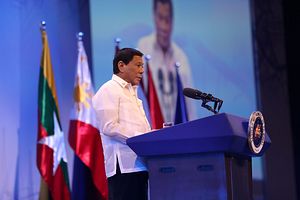On New Year’s Day 2018, Singapore will formally succeed the Philippines as the chairman of ASEAN, which plays a leading role in the Indo-Asia-Pacific by shaping the region’s multilateral architecture. With great powers unable to lead regional institutions due to the lack of mutual trust and perception of legitimacy, as Amitav Acharya pointed out, “[t]here is currently no alternative to ASEAN’s convening power in Asia.” Mindful of its centrality, ASEAN also plays a role in the region’s security challenges, foremost of which is the contentious South China Sea (SCS) dispute.
A loose grouping of diverse countries, ASEAN operates primarily through the principles of consensus and consultation, which in practice means that every member-state has veto power. Arguably, these guiding principles have led to some success in ASEAN’s diplomatic efforts. However, recent events suggest that, underpinned by these principles, ASEAN appears to show some signs of strain in addressing regional security issues, including the SCS. As one scholar argued: “the [SCS dispute] will be hard case test of ASEAN’s capacity and will to resolve or manage disputes affecting not only member states’ security and well-being, but also affecting regional peace and stability as a whole.”
Indeed, ASEAN finds itself in an environment of immense foreign policy challenges, foremost of which is rivalry among major powers, with the SCS as a potential flashpoint. Taking into account these strategic constraints, it is noteworthy to point out that ASEAN, under the chairmanship of the Philippines, has nevertheless made some gains on regional security cooperation, including the SCS, through defense diplomacy. Specifically, Manila’s ASEAN stewardship made progress in three areas.
First, the Manila-led 11th ASEAN Defense Ministers’ Meeting (ADMM) made some progress in developing crisis management mechanisms. The defense ministers adopted guidelines for maritime interaction, which aims to, among others, “establish comprehensive and feasible maritime conflict management measures on the basis of confidence-building, preventive diplomacy, and peaceful management of tensions that could arise at sea.” In addition, ASEAN created a working group to develop guidelines on air encounters between military aircraft. Albeit in the initial stages, these agreements can nevertheless complement existing crisis management mechanisms which aim to prevent and/or deescalate tensions.
Second, the ADMM also moved to strengthen dialogue and cooperation platforms, in particular the ADMM-Plus. The ASEAN defense ministers adopted the proposal of Singapore and Vietnam to annualize its meeting with the Plus countries (Australia, China, India, Japan, New Zealand, Russia, South Korea, and the United States). Moreover, ASEAN Region Forum (ARF)-led meetings among defense officials, also hosted by Manila, discussed initiatives on how to enhance defense cooperation. These platforms, it must be noted, are additional channels of communication among the major powers, including the United States and China.
Third, in its work program for 2017-2019, it is interesting to note that ADMM sought to enhance capacity building and interoperability among the defense establishments in Southeast Asia through the exploration and promotion of “agreements on status of visiting forces between ASEAN Member States [AMS].” In an apparent attempt to flesh out this work item, the ADMM agreed on principles for education and training among ADMM members. The objective of this initiative, according to the defense ministers, is to “outline the status of forces present in one [AMS] for the purpose of such training.”
Clearly, while there have been challenges in articulating ASEAN’s position on traditional security issues, particularly the SCS, the organization has nevertheless made some modest progress in initiating measures, through defense diplomacy, that may contribute in diffusing tensions in Southeast Asia’s maritime heartland. ASEAN must ensure that such measures are sustained.
Beyond these initiatives, however, the crucial test for ASEAN diplomacy remains the negotiations for a binding Code of Conduct (COC) in the SCS. Under the Philippine chairmanship, ASEAN and China adopted the “framework” COC and announced that they “will officially commence substantive negotiations on the text of the COC.” Such negotiations, however, will take place against the backdrop of China’s continued military build-up in SCS, as Beijing bolsters the infrastructure in its reclaimed islands.
As I have argued in an earlier piece, the challenge for ASEAN is to navigate within two extremes. On the one hand, ASEAN’s leading role in addressing traditional security concerns will ensure its relevance in the evolving regional security architecture. But on the other hand, the same issues, like the SCS, may further risk exposing the internal divisions in ASEAN and could affect its centrality. The apparent shifts in the language of ASEAN pronouncements on the SCS are indicative of the group’s internal diplomatic wrangling.
As the security environment continues to evolve, it is apparent that ASEAN’s diplomatic initiatives will be constrained by the realpolitik of the Indo-Asia-Pacific region. What ASEAN can and cannot do in the realm of traditional security will be significantly influenced by the dynamics of the individual member-states’ relations with and among the major powers.
Mico A. Galang is a researcher at the National Defense College of the Philippines (NDCP). The views expressed are the author’s alone and do not necessarily reflect the official position of NDCP.

































